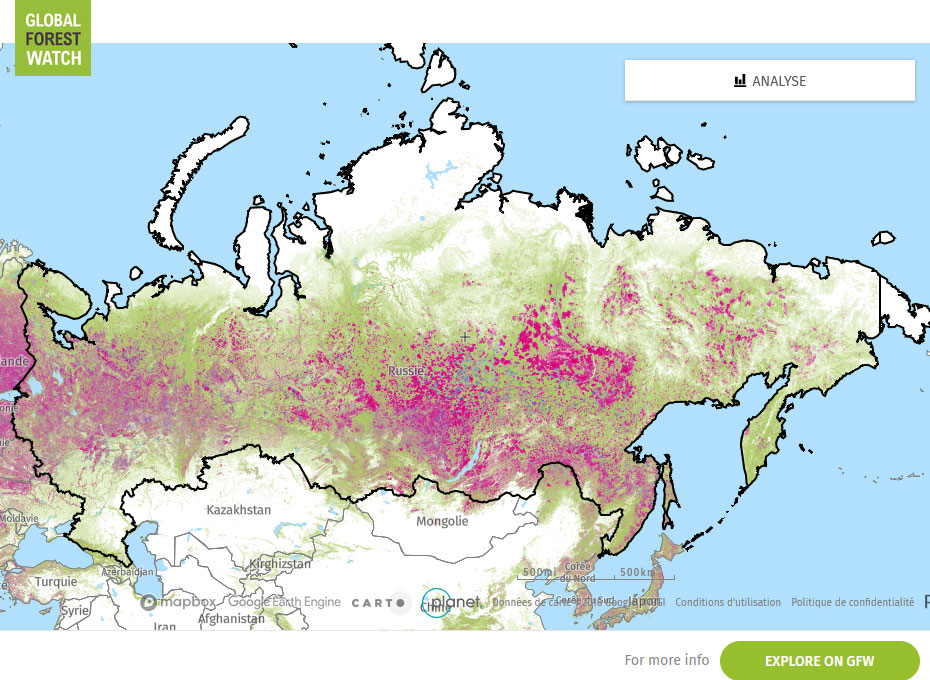Forest resources and context of Russia
UPDATING IN PROGRESS
(Conflict in Ukraine - Embargo and certification’s suspension - 2022)
Russia is home to more than one-fifth of the world’s forest areas. Around 33.5% of the total forested area is composed of primary forests, 64.1% of otherwise naturally regenerated forests, and the remaining 2.4% of planted forest.

Land surface
1637.7million ha
Forest cover
814.9million ha
Production forest
415.1million ha
Forest ownership
99.2% publicly
Forest resources in russia
Types of forest
With 7,7 million km2, the Russian boreal forests (also known in Russia as the taiga) represent 67% of Russia’s total forest land (Forest of the World and Russia, 2001) and is the largest forested region on Earth (larger than the Amazon). These forests have relatively few tree species, and they are composed mainly of birch, pine, spruce, and fir, along with some other deciduous species. Mixed-in among the forests are bogs, fens, marshes, shallow lakes, rivers and wetlands, which hold vast amounts of water. These forests contain more than 55% of the world’s conifers, and 11% of the world’s biomass. (WWF)
Russia is home to more than one-fifth of the world’s forest areas. According to the FAO Global Forest Resources Assessment 2015 and official Rosleskhoz data, Russia, also officially known as the Russian Federation (RF), has around 11.47 million km2 of forest land and other wooded land, which constitutes 49.8% of the total land area of Russia. The area of the forest land actually covered by forests is 7,95 million km2 (Russian Government, 2020). Around 33.5% of the total forested area is composed of primary forests, 64.1% of otherwise naturally regenerated forests, and the remaining 2.4% of planted forest.
The Russian landscape is highly diverse, including polar deserts, arctic and sub-arctic tundra, boreal and semi-tundra larch forests, boreal and temperate coniferous forests, temperate broadleaf and mixed forests, forest-steppe and steppe (temperate grasslands, savannahs, and shrub-lands), semi-deserts and deserts.
Russia’s boreal region also includes several important eco-regions. Among these is the Eastern-Siberian taiga, which contains the largest expanse of untouched boreal forest in the world. Russia’s largest populations of brown bear, moose, wolf, red fox, reindeer, and wolverine can also be found in this region.
Many indigenous and local people in Russia’s less developed regions rely heavily on the forest for timber harvesting, and non-timber forest product collection (e.g. berries, mushrooms, medicinal plants), traditional agriculture (e.g. grazing, hay making), and hunting. Almost all of the 45 officially registered indigenous nationalities depend on the use of forest and other wild natural resources (tundra, marine, freshwater) for their subsistence.
According to the FAO, the forested area has been growing slowly, by 0.03% per year, mainly due to natural expansion, over the last 25 years. The main pressure on Russian forests is caused by timber extraction and other forestry activities. Demand for resources in world markets, such as timber in China and Southeast Asia, and pulp in Europe, is increasingly threatening Russian forests. Forest fires are also a major threat to the region. The forest loss due to fire ranges from one to three million hectares per year. Siberian forests are particularly at risk. (WWF Russia).
Russia has more than 12,850 national, regional, and local protected areas, covering 200 million hectares or 11.9% of the country. Federally-managed protected areas, including 109 strict nature reserves (zapovedniks), 63 national parks, 61 federal sanctuaries or wildlife refuges (zakazniks) and 84 natural reserve sites (natural monuments), cover 66 million hectares or about 3.9% of the country’s territory. (Transparent world, 2014; OOPT, 2019). In addition to these protected areas, Russia has over 281 million hectares of protected forest (such as water protection zones, cedar nuts using zones etc.), 268 million hectares of reserve forest located in economically inaccessible territories, and many protected forest sites within exploitable forests. The share of protected forests is fluctuating from 3 to 60%, depending on the particular region and/or forest management unit. All of these categories of forests have different protection regimes and, in most of them, clear cutting is not allowed.
Forest ownership in Russia
100% of the Russian forest land is publicly owned.
key figures
| Land surface | 1637.7 million hectares |
|---|---|
| Forest cover | 814.9 million hectares (49.8%); mostly primary and other naturally regenerated forest 2.4% (19.8 million hectares) is planted forest |
| Production forest | 415.1 million hectares designated for production |
| Forest ownership | 99.2% publicly owned 0.8% privately owned |
| Annual change rate | 0.07% per year; over the past 25 years (1990-2015) |
Source: FAO, 2015
See also: Global Forest Ressources Assessment 2020, FAO



